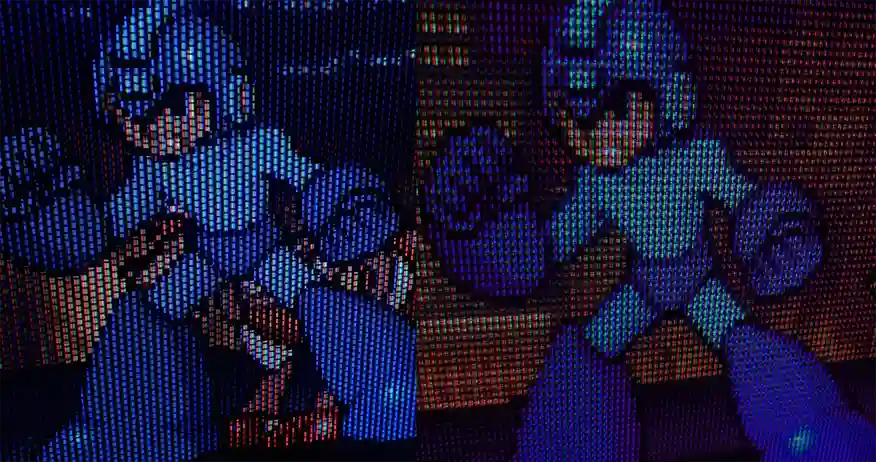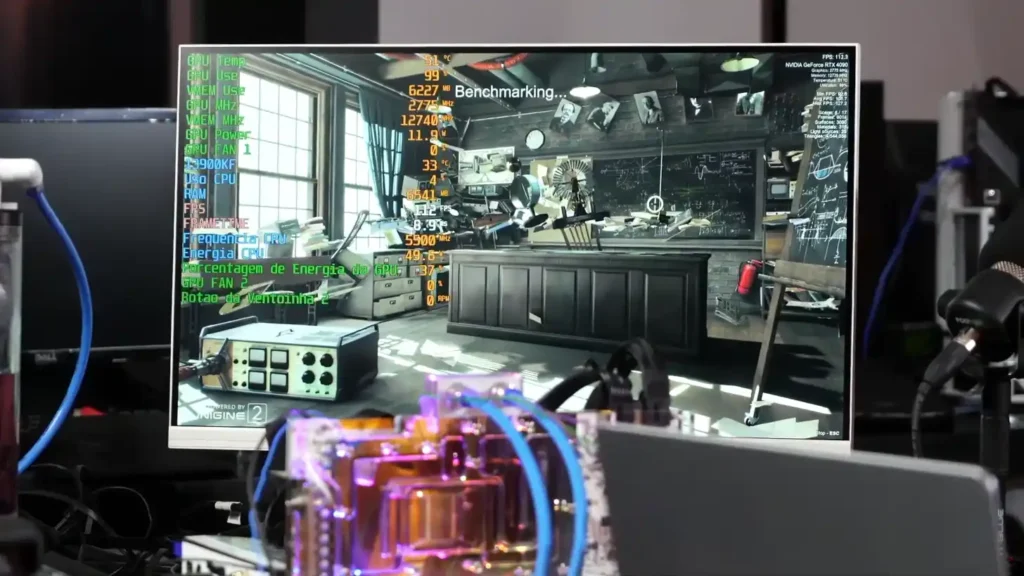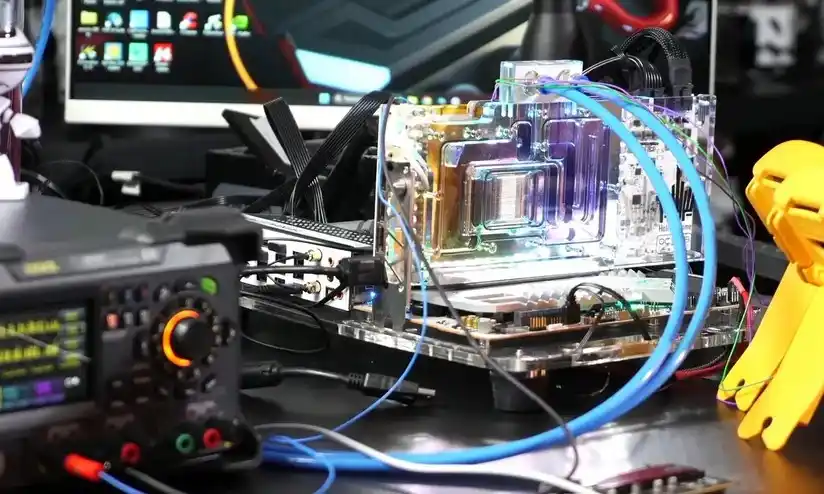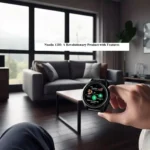When diving into retro gaming or exploring classic graphics with modern tools, you may have encountered CRT filters, a nostalgic addition to games and emulators.
These filters aim to replicate the look and feel of old CRT monitors, which were once the standard display for gaming and other media.
However, one common issue many gamers face is the significant strain these filters can put on their GPUs.
In this blog, we’ll discuss what are crt filters and why does CRT filters take so much GPU power.
Table of Contents
What Are CRT Filters?

Before delving into the GPU side of things, let’s first understand what CRT filters are. CRT, or Cathode Ray Tube, was the primary technology for monitors and televisions before the age of flat screens.
These older displays had a distinct look, marked by things like visible scanlines, slight screen curvature, and phosphor bloom – all of which contributed to their unique charm.
Today, CRT filters are used in modern gaming and emulation to recreate these nostalgic visuals, bringing back the retro aesthetic for players who want to experience older games as they originally appeared.
The filters simulate the various imperfections of CRT screens, such as the scanlines and the warm glow of phosphor, that many gamers associate with the golden era of gaming.
The Role of a GPU in Rendering
The GPU (Graphics Processing Unit) plays a pivotal role in rendering the images and animations we see on screen.
In simpler terms, the GPU is the muscle behind any kind of graphics-heavy application, whether it’s a video game, a movie, or 3D rendering software. Its job is to process the graphical data and turn it into visual content, from basic 2D graphics to complex 3D environments.
In gaming, the GPU is essential for producing smooth gameplay, detailed textures, and seamless visual effects. High-end GPUs enable faster rendering speeds and better overall performance. But when you add additional effects like CRT filters, the GPU is tasked with much more than it would typically handle.
How CRT Filters Work
At a basic level, CRT filters are designed to replicate the look of an old CRT screen. They achieve this by manipulating the image in several ways, such as:
- Scanlines: These are the horizontal lines that run across a CRT display. Filters simulate the appearance of these lines to give the image a more retro feel.
- Phosphor Bloom: The glow that appears on old CRT screens when pixels “bloom” or spread their light.
- Curvature: CRT screens had a slight curve to them, which some filters emulate for visual authenticity.
- Color Shifts: CRT screens often had slightly distorted colors due to their technology. Modern filters replicate this effect for realism.
These effects are complex to reproduce. They often involve multiple algorithms and layers of processing, which can significantly increase the computational load on your GPU.
Why Does CRT Filters Take So Much GPU Power?
When you enable CRT filters, you’re asking your GPU to apply multiple visual effects at once, often on a high-resolution screen. Here’s why these filters are so demanding:
- Increased Rendering Load: Each CRT effect requires the GPU to do extra work, rendering an image with scanlines, curvatures, and other intricate details. This increases the number of calculations the GPU has to perform.
- Complex Algorithms: Simulating old CRT behaviors like phosphor bloom or scanline effects isn’t as simple as just overlaying a static image. The algorithms that simulate these effects are quite intricate and need significant computational resources.
- High Texture Demands: Many CRT filters also require high-quality textures to simulate the look of old screens. These textures can consume a lot of GPU memory, especially when working at higher resolutions.
All of these factors combine to make CRT filters a heavy load on your GPU, leading to performance drops and a decrease in frame rates.
The Impact of CRT Filters on Frame Rate and Performance
When you enable CRT filters, particularly in older or less powerful hardware setups, you may notice a significant drop in frame rates. The visual enhancements come at a cost, and the higher the complexity of the filter, the harder your GPU will have to work to keep up.
This performance hit may not be as noticeable on modern, high-end graphics cards, but for older systems or lower-spec PCs, it can lead to stuttering, frame rate drops, or overall sluggish performance. It’s all a result of the extra processing power required to simulate those retro CRT effects.
The Role of Software in GPU Usage
Emulators and other software used to apply CRT filters also play a major role in determining how much strain these filters place on the GPU. Well-optimized software can reduce the amount of work your GPU needs to do, while poorly optimized emulators can exacerbate the problem.
For instance, if an emulator is not designed to handle the GPU load efficiently, it may end up overloading the system, resulting in performance bottlenecks. It’s crucial to ensure that you’re using high-quality, well-optimized software for the best experience.
GPU Load vs. CPU Load in CRT Filtering
While the CPU does handle some processing tasks related to gaming and graphics, the GPU is the component that is most heavily impacted when CRT filters are applied. This is because the GPU is responsible for rendering the image, applying filters, and manipulating textures in real-time.
Although the CPU assists in tasks like game logic and AI, the visual workload falls squarely on the GPU. As a result, the additional burden placed by CRT filters is typically felt more on the GPU than the CPU.
Optimizing GPU Usage with CRT Filters

If you’re struggling with performance issues while using CRT filters, there are a few ways to optimize GPU usage:
- Lower Resolution: Reducing the screen resolution can lessen the GPU’s burden, making it easier to render the additional effects.
- Adjust Filter Settings: Many CRT filters offer customization options. Reducing the intensity of effects like scanlines or bloom can help lower GPU usage.
- Use Performance Mode: Some emulators offer a “performance mode,” which prioritizes smooth gameplay over graphical fidelity.
Are CRT Filters Worth the GPU Strain?
This ultimately depends on what you value most in your gaming experience. For those who want a nostalgic, retro feel and are willing to sacrifice some performance for aesthetics, CRT filters are a worthwhile addition.
However, if smooth gameplay and high frame rates are your top priorities, you may want to reconsider using these resource-intensive filters.
Future of CRT Filters in Gaming and Graphics
The future of CRT filters in gaming and graphics is an exciting one, especially as hardware and software technology continues to evolve.
As GPUs get more powerful and more efficient, the strain placed on these systems by complex visual effects like CRT filters is likely to decrease. Here are some key areas that will shape the future of CRT filters:
AI-Assisted Rendering
One of the most promising advancements on the horizon is the integration of artificial intelligence in graphic rendering. AI can help optimize and automate several processes that currently demand significant computational resources.
For example, AI could be used to analyze scenes and apply CRT effects in a more efficient way, reducing the load on the GPU.
Better Emulation Algorithms
The algorithms used to simulate CRT screens are complex, but advancements in software development may help streamline these processes.
For example, machine learning could enable software to “learn” how different CRT monitors behave and more accurately replicate their visual effects with minimal GPU usage.
Higher-quality GPUs with Enhanced Ray Tracing Capabilities
Ray tracing is one of the most cutting-edge technologies in gaming today, providing incredibly realistic lighting and reflections.
As GPUs continue to advance with better ray tracing support, they will also be able to handle more complex visual effects, including those used in CRT filtering.
With higher-quality GPUs, it may become possible to run both ray tracing and CRT filters without significantly impacting performance.
Cloud Gaming and Offloading
Another factor that may influence the future of CRT filters is the rise of cloud gaming. Services like Google Stadia, NVIDIA GeForce Now, and Xbox Cloud Gaming allow users to play high-performance games on low-spec devices by offloading processing to remote servers.
As cloud gaming becomes more prevalent, the burden of running complex visual effects like CRT filters may no longer fall on local hardware.
Alternatives to CRT Filters
While CRT filters are a beloved feature for those seeking to relive the retro gaming experience, not everyone is keen on the performance sacrifices they bring.
For gamers who are looking for alternatives that don’t burden their systems as heavily, here are a few viable options:
1. Scanline Shaders
One of the simplest alternatives to full CRT filters is the use of scanline shaders. These shaders replicate the visual effect of scanlines without adding all the extra visual effects, such as phosphor bloom or curvature.
While not as comprehensive as a full CRT filter, scanline shaders still provide that retro aesthetic without the heavy performance cost.
Many emulators and games offer customizable scanline shaders that let you adjust the intensity to your liking.
2. Pixelation Filters
Pixelation filters are another common alternative for those seeking a retro look. These filters mimic the low-resolution graphics of older games by reducing the smoothness of textures and increasing pixelation. It’s a lightweight option that adds a nostalgic touch without putting too much strain on the GPU.
3. CRT Emulation with Lower Intensity Effects
Some emulators offer CRT filter effects with lower intensity settings. For example, instead of applying a heavy bloom effect or a pronounced curvature, you can adjust the filter to simulate a softer, less demanding version of the CRT experience.
By dialing down the intensity of the various CRT emulation effects, you can still enjoy the nostalgia without overwhelming your GPU.
4. Faux-CRT Options via Post-Processing
Some modern graphical engines and post-processing techniques offer ways to simulate the look of CRT screens through non-invasive means.
These effects, often designed for performance-oriented setups, apply a range of visual tricks such as light blooms or a slight blur to imitate the imperfections of older screens.
While not identical to CRT filters, they can evoke a similar sense of nostalgia and are much less resource-intensive.
Read Also: Nuoilo 12H: A Revolutionary Product with Features
Conclusion
In conclusion, CRT filters demand a lot from your GPU because they simulate intricate, resource-heavy effects designed to replicate the nostalgic feel of old CRT screens.
While these filters provide a unique visual experience, they come at the cost of performance. With proper optimization and understanding of their demands, however, you can strike a balance between aesthetic appeal and gameplay smoothness.
FAQs
Q 1. What are CRT filters used for?
CRT filters are used to replicate the look of old CRT monitors, including effects like scanlines and phosphor bloom.
Q 2. Why do CRT filters affect performance?
CRT filters require complex algorithms and high-resolution textures, putting a significant load on the GPU.
Q 3. Can I optimize performance when using CRT filters?
Yes, lowering resolution or adjusting filter settings can help optimize performance.
Q 4. Are CRT filters necessary for retro gaming?
While not necessary, they provide a nostalgic experience for those who want to replicate the old CRT screen aesthetics.



